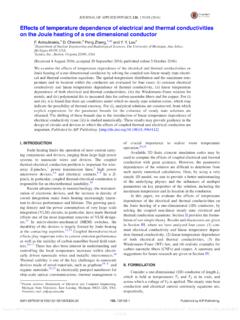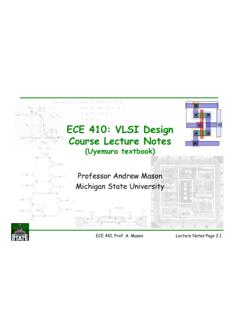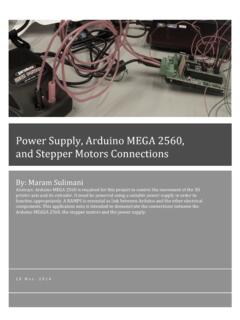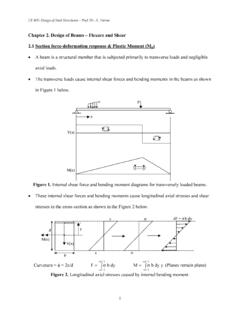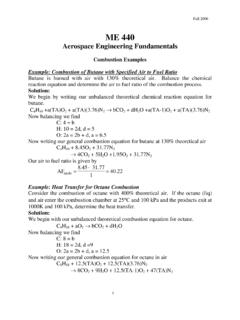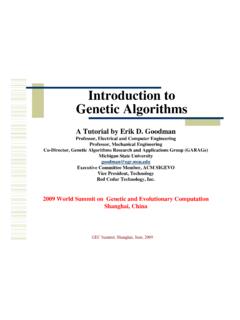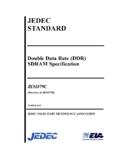Transcription of no capabilities for “online” memory Write operations ...
1 memory Basics RAM: Random Access memory historically defined as memory array with individual bit access refers to memory with both Read and Write capabilities ROM: Read Only memory no capabilities for online memory Write operations Write typically requires high voltages or erasing by UV light Volatility of memory volatile memory loses data over time or when power is removed RAM is volatile non-volatile memory stores date even when power is removed ROM is non-volatile Static vs. Dynamic memory Static: holds data as long as power is applied (SRAM). Dynamic: must be refreshed periodically (DRAM). ECE 410, Prof. A. Mason Lecture Notes SRAM Basics SRAM = Static Random Access memory Static: holds data as long as power is applied Volatile: can not hold data if power is removed 3 Operation States hold Write WL.
2 Read Basic 6T (6 transistor) SRAM Cell bistable (cross-coupled) INVs for storage access transistors MAL & MAR MAL MAR. access to stored data for read and Write word line, WL, controls access bit bit WL = 0, hold operation WL = 1, read or Write operation ECE 410, Prof. A. Mason Lecture Notes SRAM operations WL=0. Hold word line = 0, access transistors are OFF. data held in latch MAL MAR. Write word line = 1, access tx are ON bit bit new data (voltage) applied to bit and bit_bar data in latch overwritten with new value WL=1. Read word line = 1, access tx are ON. MAL MAR. bit and bit_bar read by a sense amplifier Sense Amplifier bit bit basically a simple differential amplifier comparing the difference between bit and bit_bar if bit > bit_bar, output is 1.
3 If bit < bit_bar, output is 0. allows output to be set quickly without fully charging/discharging bit line ECE 410, Prof. A. Mason Lecture Notes SRAM Bit Cell Circuit Two SRAM cells dominate CMOS industry 6T Cell all CMOS transistors better noise immunity 4T Cell replaces pMOS with high resistance (~1G ) resistors slightly smaller than 6T cell requires an extra high -resistance process layer ECE 410, Prof. A. Mason Lecture Notes 6T Cell Design Critical Design Challenge inverter sizing to ensure good hold and easy/fast overwrite use minimum sized transistors to save area unless more robust design required Write Operation both bit and bit_bar applied inputs to inverters both change unlike DFF where one INV overrides the other critical size ratio, A/ n Write 1 Operation see resistor model want Rn & Rp larger than RA.
4 So voltage will drop across Rn, Rp typical value, A/ n=2. so Rn = 2 RA. set by ratio (W/L)A to (W/L)n Resistor Model ECE 410, Prof. A. Mason Lecture Notes SRAM Cell Layout Design Challenge minimum cell size (for high density SRAM array). with good access to word and bit lines Example Layout note WL routed in poly will create a large RC delay for large SRAM array ECE 410, Prof. A. Mason Lecture Notes Multi-Port SRAM. Allows multiple access to the same SRAM cell simultaneously. Provide high data bandwidth. Applications Register file Cache inverter feedback loop Network switch ASIC etc. Ws1. A multi-port SRAM cell Ws2. schematic. Each port has two access transistors D1. D1. D2. D2. two bit line bit_bar one word selection line.
5 Bit access access one address decoder ECE 410, Prof. A. Mason Lecture Notes Multi-Port SRAM (cont.). Challenges in multi-ports SRAM. layout size increases quadratically with # of ports more word selection lines more bitline lines lower speed and higher power consumption Multi-port SRAM options for ECE410 Design Project Two ports 1 port read and Write 1 port read only Three ports 2 ports for read and 1 port for Write ECE 410, Prof. A. Mason Lecture Notes SRAM Arrays N x n array of 1-bit cells n = byte width; 8, 16, 32, etc. N = number of bytes m = number of address bits Control Data I/O. max N = 2m Array I/O. data, in and out Dn-1 - D0 Address address Am-1 - A0. control varies with design WE = Write enable (assert low). WE=1=read, WE=0= Write En = block enable (assert low).
6 Used as chip enable (CE) for an SRAM chip ECE 410, Prof. A. Mason Lecture Notes SRAM Block Architecture Example: 2-Core design core width = k n n = SRAM word size; 8, 16, etc. k = multiplier factor, 2,3,4,etc. shared word-line circuits Basic SRAM. horizontal word lines Block Architecture WL set by row decoder placed in center of 2 cores WL in both cores selected at same time Addressing Operation address word determines which row is active (which WL =1) via row decoder row decoder outputs feed row drivers buffers to drive large WL capacitance Physical Design layout scheme matches regular patterning shown in schematic horizontal and vertical routing Expanded Core View ECE 410, Prof. A. Mason Lecture Notes SRAM Array Addressing Standard SRAM Addressing Scheme consider a N x n SRAM array N = number of bytes, , 512, 2k n = byte size, , 8 or 16.
7 M address bits are divided into x row bits and y column bits (x+y=m). address bits are encoded so that 2m = N. array organized with both both vertical and horizontal stacks of bytes 1 SRAM byte Rows Columns ECE 410, Prof. A. Mason Lecture Notes SRAM Array Addressing Address Latch Address Latch D-latch with enable and output buffers outputs both A and A_bar Address Bits Row address bits = Word Lines, WL. Column address bits select a subset of bits activated by WL. Column Organization typically, organized physically by bits, not by bytes Example, SRAM with 4-bit bytes in 3 columns (y=3). 3 4-bit bytes in each row 4th bits 3rd bits 2nd bits 1's bits 1 SRAM bit (Row) Word Line Byte 1. y0 Byte 2. Column Byte 3. y Address 1. y2.
8 Vertical bit lines D3 D2 D1 D0 bit_bar not shown ECE 410, Prof. A. Mason Lecture Notes SRAM Array Column Circuits SRAM Row Driver Row Driver Circuit decoder output, Dec_out pull- enable, En, after address bits decoded ups Row Decoder/Driver activate a row of cells size-scaled buffers each 2-core row contains 2k bytes (2k n bits). Column Multiplexers address signals select one of the k bytes as final output not used in row decoder Column MUX/DeMUXs figure shows example for k=3. for an 8-bit RAM (word size). MUX used for Read operations De MUX used for Write Column Drivers bit/bit_bar output for Write operations Column Driver Circuit ECE 410, Prof. A. Mason Lecture Notes Column Circuitry Precharge Concept common to use dynamic circuits in SRAMS.
9 Dynamic circuits have precharge and evaluate phases precharge high capacitance on bit lines avoids heavy capacitive loading on each SRAM cell Precharge Phase all bit lines pulled to VDD. all bit_bar to ground Evaluate Phase bits activated by WL connect to bit lines if data = 1, keep precharged value if data = 0, discharge bit line Data In Data Out ECE 410, Prof. A. Mason Lecture Notes Bit line (column) Circuitry expanded (transistor-level) view of SRAM column pMOS precharge loads word lines - charge when = 0 (row address). nMOS switches select column which column/bit is address passed to Read/ Write circuit ECE 410, Prof. A. Mason Lecture Notes Sense Amplifiers Read sensing scheme look at differential signal bit and bit_bar can get output before bit lines Differential fully charge/discharge by Amplifier amplifying differential signals Differential Amplifier simple analog circuit output high if bit > bit_bar output low if bit_bar > bit can implement as dynamic circuit ECE 410, Prof.
10 A. Mason Lecture Notes DRAM Basics DRAM = Dynamic Random Access memory Dynamic: must be refreshed periodically Volatile: loses data when power is removed Comparison to SRAM. DRAM is smaller & less expensive per bit SRAM is faster DRAM requires more peripheral circuitry 1T DRAM Cell single access nFET. storage capacitor (referenced to VDD or Ground). control input: word line, WL. data I/O: bit line ECE 410, Prof. A. Mason Lecture Notes DRAM Operation RAM data is held on the storage capacitor temporary due to leakage currents which drain charge Charge Storage if Cs is charged to Vs Qs = Cs Vs if Vs = 0, then Qs = 0: LOGIC 0. if Vs = large, then Qs > 0: LOGIC 1. Write Operation turn on access transistor: WL = VDD. apply voltage, Vd ( high or low), to bit line Cs is charged (or discharged).


